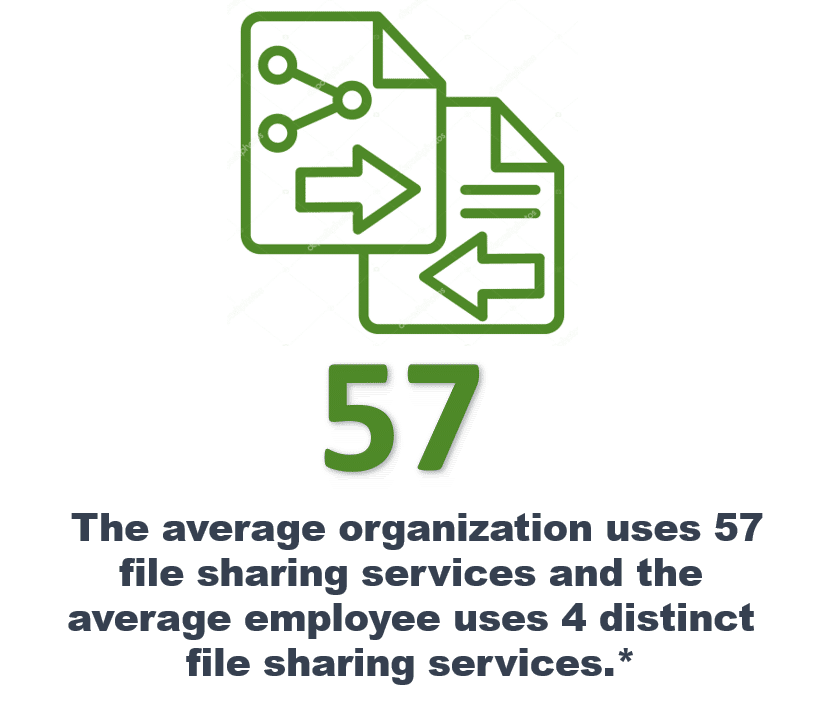
File sharing and collaboration have significantly evolved over time, with first-generation platforms paving the way for innovative Zero Trust Data Access solutions like FileFlex. While both types of platforms offer collaboration and sharing features, they diverge in their approach to data access, storage architecture, network file access, Windows integration, data governance, IT control, file sharing and collaboration, ransomware risk reduction, and regulatory compliance.
File Sharing and Collaboration Evolution from First Generation Platforms to Zero Trust Data Access
Estimated reading time: 4 minutes
Table of Contents
How Have File Sharing and Collaboration Platforms Evolved?

How Do First Generation File Sharing Solutions Compare to Zero Trust Based Solutions?
First-generation file-sharing and collaboration platforms, such as Google Drive, Box, OneDrive, Box, Egnyte, Citrix and Kiteworks, transformed the way organizations manage and share files. These platforms focused on providing access and management of files stored within their centralized infrastructure. However, they have necessitated the duplication or syncing of files to a centralized server and lacked direct access to files stored in other locations. Although the enterprise versions offer real-time collaboration and workflow automation, their functionality remained limited to the files stored on their respective platforms.
On the other hand, Zero Trust Data Access as implemented in FileFlex represents a new paradigm in secure file access. This innovative generation enables secure access to files and folders across an entire organizational infrastructure, spanning on-premises, cloud-hosted, and SharePoint storage. Zero Trust Data Access excels in providing enhanced access control, micro-segmentation, the least privilege principle, activity tracking and authentication, compliance with privacy regulations, adaptability, scalability, improved insider threat mitigation, reduced risk of ransomware, and robust support for data governance across the entire organizational infrastructure, not just for files stored in a managed silo.
Top 8 Differences Between First-Generation File-Sharing Solutions and Zero Trust Data Access
1. Centralized vs Decentralized Storage
The primary differentiator between first-generation file sharing platforms and Zero Trust Data Access as implemented by FileFlex lies in their storage architectures. First-generation platforms predominantly rely on a centralized approach, requiring files to be copied or synced to a central server. In contrast, Zero Trust Data Access is a storage infrastructure overlay that embraces a decentralized approach where users access files from their original storage locations. This approach grants organizations greater flexibility, efficient resource utilization, enhanced security, and reduced costs by eliminating the need for file duplication while enabling seamless access to files stored across diverse locations.
2. File Sharing and Collaboration
Both first-generation file sharing platforms and the Zero Trust Data Access platform as implemented by FileFlex offer file sharing and collaboration features, but first-generation platforms are limited to sharing and collaboration of files stored on their platforms, while FileFlex is a storage overlay that enables sharing and collaboration with files stored anywhere on the organizational infrastructure.
3. Windows File Explorer Integration
Both first-generation platforms and Zero Trust Data Access platforms offer integration with Windows File Explorer. However, first-generation platforms’ Windows integration typically applies solely to the files stored on their centralized servers. In contrast, ZTDA takes a federated approach, seamlessly incorporating all disparate storage locations into the Windows environment. As a result, FileFlex provides full Windows functionality for all storage accessed anywhere, facilitates sharing from any repository within Windows, and empowers users with in-app file operations directly from remote repositories.
4. Network File Access, Network File Access Control and Network Security
Network file access, network file access control, and network security are beyond the scope of first-generation platforms. Conversely, Zero Trust Data Access as implemented by FileFlex goes above and beyond by offering granular access control, subfolder access, hidden servers, and appliances, and prohibiting access to data VLANs. By diligently tracking and controlling user network access, FileFlex minimizes the attack surface, aligns with compliance requirements, and helps mitigate insider threats.
5. Data Governance
In terms of data governance, first-generation file sharing platforms typically limit governance measures to files stored exclusively on their platforms. In contrast, ZTDA as implemented by FileFlex strengthens cybersecurity by enforcing access controls, segmenting data, tracking and authenticating users, adhering to the least privilege principle, and implementing protection measures across the entire organizational storage infrastructure. By aligning with comprehensive data governance principles, FileFlex bolsters the overall security posture of organizations.
6. IT Control
Finally, when it comes to IT control with distributed administration, it is beyond the scope of first-generation platforms to provide IT control over the complex organizational infrastructure of unstructured data. The Zero Trust Data Access of FileFlex’s advanced data governance capabilities, however, enables centralized control over file access and distributed administration for branch offices, subsidiaries, partners, and vendors. This empowers organizations to maintain consistent and secure governance across their entire file ecosystem.
7. Regulatory Compliance
Regulatory compliance is another crucial area where first-generation file sharing platforms and ZTDA as implemented by FileFlex diverge in their capabilities. First-generation platforms primarily focus on aiding compliance for files stored within their platforms, ensuring that files stored and shared through their systems generally adhere to regulatory standards. On the other hand, FileFlex offers organizations a comprehensive solution to protect access to all their unstructured data storage repositories, helping them comply with regulatory requirements across their entire infrastructure. It’s zero trust architecture facilitates compliance by providing organizations with detailed requirements for authentication, authorization, access control, monitoring, encryption, activity logs, auditing, and data governance.
8. Reducing the Risk of Ransomware
When it comes to reducing the risk of ransomware, first-generation platforms are not designed for this purpose, while Zero Trust Data Access as implemented by FileFlex provides access controls, restrictions on lateral movement, and activity monitoring that help detect and prevent ransomware attacks.
Summary
In conclusion, the evolution of file sharing and collaboration platforms has led to the emergence of Zero Trust Data Access solutions like FileFlex. With its decentralized storage approach, advanced security features, comprehensive data governance capabilities, regulatory compliance support, and enhanced file sharing and collaboration functionalities, FileFlex represents a powerful solution that empowers organizations to secure their data access and sharing across their entire infrastructure.
To learn more, check out some of our related blogs such as What is Zero Trust Data Access (ZTDA)?, and The FileFlex Enterprise Commercial Platform for Zero Trust Data Access.
Learn More About FileFlex Sign Up for a Free Trial